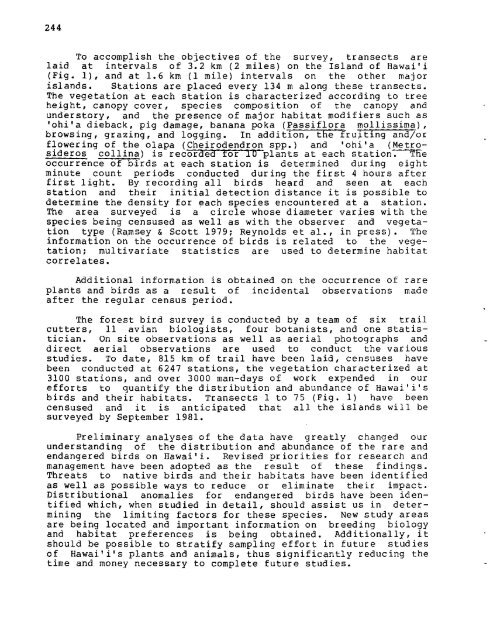June 1 - 3 , 1978 - University of Hawaii at Manoa
June 1 - 3 , 1978 - University of Hawaii at Manoa
June 1 - 3 , 1978 - University of Hawaii at Manoa
Create successful ePaper yourself
Turn your PDF publications into a flip-book with our unique Google optimized e-Paper software.
To accomplish the objectives <strong>of</strong> the survey, transects are<br />
laid <strong>at</strong> intervals <strong>of</strong> 3.2 km (2 miles) on the Island <strong>of</strong> Hawai'i<br />
(Fig. I), and <strong>at</strong> 1.6 km (1 mile) intervals on the other major<br />
islands. St<strong>at</strong>ions are placed every 134 m along these transects.<br />
The veget<strong>at</strong>ion <strong>at</strong> each st<strong>at</strong>ion is characterized according to tree<br />
height, canopy cover, species composition <strong>of</strong> the canopy and<br />
understory, and the presence <strong>of</strong> major habit<strong>at</strong> modifiers such as<br />
'ohi'a dieback, pig damage, banana p6ka (Passiflora mollissima),<br />
browsinq, - qrazina, - and loaqina. In addition, the fruitinq and/or<br />
flowering <strong>of</strong> thedblapa (~heirodendron spp. ) and 'ohi 'a - ( ~etiosideros<br />
collina) is recorded tor 10 plants <strong>at</strong> each st<strong>at</strong>ionxe<br />
occurrence <strong>of</strong> birds <strong>at</strong> each st<strong>at</strong>ion is determined during eight<br />
minute count periods conducted during the first 4 hours after<br />
first light. By recording all birds heard and seen <strong>at</strong> each<br />
st<strong>at</strong>ion and their initial detection distance it is possible to<br />
determine the density for each species encountered <strong>at</strong> a st<strong>at</strong>ion.<br />
The area surveyed is a circle whose diameter varies with the<br />
species being censused as well as with the observer and veget<strong>at</strong>ion<br />
type (Ramsey & Scott 1979; Reynolds et al., in press). The<br />
inform<strong>at</strong>ion on the occurrence <strong>of</strong> birds is rel<strong>at</strong>ed to the veget<strong>at</strong>ion;<br />
multivari<strong>at</strong>e st<strong>at</strong>istics are used to determine habit<strong>at</strong><br />
correl<strong>at</strong>es.<br />
Additional inform<strong>at</strong>ion is obtained on the occurrence <strong>of</strong> rare<br />
plants and birds as a result <strong>of</strong> incidental observ<strong>at</strong>ions made<br />
after the regular census period.<br />
The forest bird survey is conducted by a team <strong>of</strong> six trail<br />
cutters, 11 avian biologists, four botanists, and one st<strong>at</strong>is-<br />
tician. On site observ<strong>at</strong>ions as well as aerial photographs and<br />
direct aerial observ<strong>at</strong>ions are used to conduct the various<br />
studies. To d<strong>at</strong>e, 815 km <strong>of</strong> trail have been laid, censuses have<br />
been conducted <strong>at</strong> 6247 st<strong>at</strong>ions, the veget<strong>at</strong>ion characterized <strong>at</strong><br />
3100 st<strong>at</strong>ions, and over 3000 man-days <strong>of</strong> work expended in our<br />
efforts to quantify the distribution and abundance <strong>of</strong> Hawai'i's<br />
birds and their habit<strong>at</strong>s. Transects 1 t o 75 (Fig. 1) have been<br />
censused and it is anticip<strong>at</strong>ed th<strong>at</strong> all the islands w i l l be<br />
surveyed by September 1981.<br />
Preliminary analyses <strong>of</strong> the d<strong>at</strong>a have gre<strong>at</strong>ly changed our<br />
understanding <strong>of</strong> the distribution and abundance <strong>of</strong> the rare and<br />
endangered birds on Hawai'i. Revised priorities for research and<br />
management have been adopted as the result <strong>of</strong> these findings.<br />
Thre<strong>at</strong>s to n<strong>at</strong>ive birds and their habit<strong>at</strong>s have been identified<br />
as well as possible ways to reduce or elimin<strong>at</strong>e their impact.<br />
Distributional anomalies for endangered birds have been iden-<br />
tified which, when studied in detail, should assist us in deter-<br />
mining the limiting factors for these species. New study areas<br />
are being loc<strong>at</strong>ed and important inform<strong>at</strong>ion on breeding biology<br />
and habit<strong>at</strong> preferences is being obtained. Additionally, it<br />
should be possible to str<strong>at</strong>ify sampling effort in future studies<br />
<strong>of</strong> Hawai'i's plants and animals, thus significantly reducing the<br />
time and money necessary to complete future studies.
















